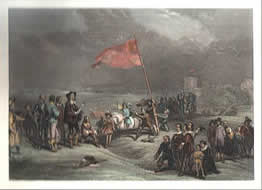The English Civil Wars

Raising the Royal Standard at Nottingham
The First Civil War began in 1642 in the aftermath of a political crisis that followed a violent revolt in Ireland, but its roots lay in the tensions that had arisen during the reign of Charles I. He came to the throne in 1625 and from 1629 ruled without calling Parliament, until the humiliating failure to impose the Anglican prayer book on the Scottish Kirk in the two Bishops’ Wars, in 1639 and 1640, led to the calling of the Long Parliament in 1640. It tackled many of the concerns that had arisen during the personal rule, but the need to raise an army to go to Ireland generated a clash with the king that worsened in the early months of 1642, as Parliament took control of the militia. During the summer both parties prepared for war, which began when the king ceremonially raised the Royal Standard at Nottingham on 22 August.
The royalists’ base was Oxford and they controlled much of the Midlands, the North, the West Country and Wales, while Parliament’s core areas were London, the Home Counties, East Anglia and the South East. A royalist march on London in 1642, which saw a drawn battle at Edgehill in Warwickshire, was halted at Turnham Green on 13 November, but they had the better of the campaigns in 1643, until their unsuccessful siege of Gloucester, followed by a drawn battle at Newbury in Berkshire in September.
An army shipped from Ireland to support the royalists was soon defeated, whereas the Scottish forces that joined the war as Parliament’s allies in 1644 made a significant contribution to its ultimate victory. This was only after Parliament’s generals suffered further defeats in 1644, and the virtual disintegration of the armies commanded by the Earl of Essex and Sir William Waller. Those royalist successes were offset by their defeat at Marston Moor outside York on 2 July and the subsequent loss of most of the north of England. They avoided a further defeat in a second battle at Newbury, but the parliamentarians could steadily concentrate their resources.
Both sides were hampered by jealous rivalries among the senior commanders. Parliament’s solution was to create the New Model Army under Sir Thomas Fairfax, with Oliver Cromwell as lieutenant-general of horse. On 14 June 1645 it decisively defeated the king’s main army at Naseby in Northamptonshire, and then his western army at Langport in Somerset, on 10 July. Left without an army that could challenge the New Model, the king was unable to protect his garrisons, which were steadily captured. Charles surrendered to the Scots on 5 May 1646, although the war continued through the summer. It had been punctuated by more than 300 sieges, of cities, towns and small garrisons. Those who had predicted a long, bloody and destructive conflict were proved correct, for few areas avoided the damaging effects of the war, which had a major impact on the country’s society and economy.
Parliament failed to negotiate a settlement with the king, while he secured the support of the Scots and revived the royalist cause. The Second Civil War, in 1648, saw scattered and uncoordinated uprisings by English royalists, which were crushed by the New Model, which also defeated an invading Scottish army at Preston in Lancashire. Angry at this unwarranted renewal of the conflict, an increasingly politicised army and its allies in Parliament sought retribution. Unsympathetic MPs were excluded from Parliament, clearing the way for the trial and execution of the king in January 1649. England then became a republic, while the Scots recognised his son as Charles II. A renewal of the war between the two kingdoms followed, with campaigns in Scotland that included the New Model’s victory at Dunbar in 1650 and, in 1651, another invasion of England by a Scottish army. That was defeated at the battle of Worcester on 3 September, which finally brought the wars in England to a close. The monarchy was restored in 1660.

